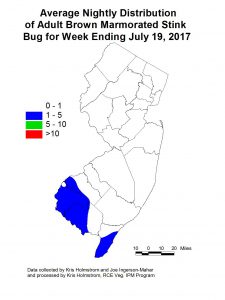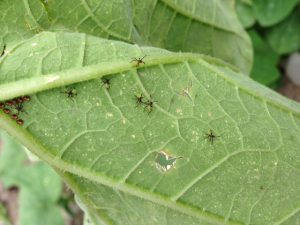Sweet Corn
European corn borer (ECB) catches continue to be very low, and no map will appear in this edition. There have been a few traps that have begun to record minor increases, however. ECB feeding in NJ sweet corn plantings is also low. Check 5 plants each in 10 random locations for a 50 plant sample. Look for “shot-hole” injury, and consider treating when the number of infested plants in a 50 plant sample exceeds 12%. As infested plants proceed to the pre-tassel stage, live larvae and damage may be found in the emerging tassels. Once plants hit full tassel, ECB larvae will move downward on the stalk and re-enter the plant near the area where ears are forming. This can result in direct injury to the ear. Growers should consider an insecticide application at the full tassel stage to target ECB larvae as they migrate downward. This application can eliminate larvae that have escaped any earlier insecticide applications.
The highest nightly ECB catches for the previous week are as follows:
| Allamuchy 1 | Milford 1 |
| Blairstown 1 | Pedricktown 1 |
| Califon 1 | South Branch 1 |
| Eldora 1 |
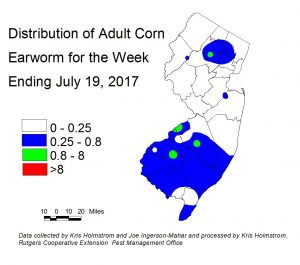 Corn earworm (CEW) moth catches have increased in much of the state this past week. Although catches are still fairly low, they represent a threat to silking sweet corn. These moths are the beginning of the mid-summer gradual increase. At present, the highest activity is in the southern counties (see CEW map at left), although catches have occurred as far north as Morris and Warren counties. CEW trap catches are generally rising now in the Carolinas, which is normal for mid-July. Large increases from Virginia northward have not yet occurred, but with each approaching frontal weather system, we can expect moderate increases in CEW catches locally. The major migratory influx of moths generally does not occur until after mid-August in NJ.
Corn earworm (CEW) moth catches have increased in much of the state this past week. Although catches are still fairly low, they represent a threat to silking sweet corn. These moths are the beginning of the mid-summer gradual increase. At present, the highest activity is in the southern counties (see CEW map at left), although catches have occurred as far north as Morris and Warren counties. CEW trap catches are generally rising now in the Carolinas, which is normal for mid-July. Large increases from Virginia northward have not yet occurred, but with each approaching frontal weather system, we can expect moderate increases in CEW catches locally. The major migratory influx of moths generally does not occur until after mid-August in NJ.
The highest nightly CEW blacklight trap catches are as follows:
| Centerton 1 | Farmingdale 1 | Pedricktown 1 |
| Cinnaminson 1 | Folsom 1 | Old Bridge 1 |
| Denville 1 | Green Creek 1 | Tabernacle 1 |
| Downer 1 | Matawan 1 | Woodstown 1 |
Southern NJ CEW pheromone trap catches have increased just slightly this past week. This more conservative network is also indicating a similar threat level to last week (see CEW pheromone map below at right). There are relatively few pheromone traps deployed compared to the number of blacklight traps in the state, resulting in much broader color bands on the pheromone map.
At present, the highest nightly pheromone trap catches are as follows: 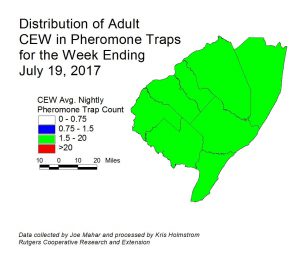
| Pole Tavern 21 | Green Creek 7 |
| Elm 15 | Woodstown 6 |
| Pedricktown 12 | Berlin 3 |
| Beckett 9 | Jobstown 2 |
| East Vineland 9 |
Fall Armyworm
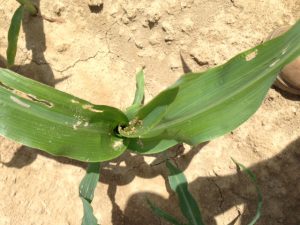 Fall armyworm (FAW) infestations in NJ have increased somewhat in southern NJ. We should expect increases to continue. This pest favors smaller whorl stage plants, and will even infest seedling stage plants if
Fall armyworm (FAW) infestations in NJ have increased somewhat in southern NJ. We should expect increases to continue. This pest favors smaller whorl stage plants, and will even infest seedling stage plants if the population is high. Infestations have been identified throughout New Jersey. This pest is capable of serious injury to plants, and scouting should commence immediately on whorl corn throughout the southern half of the state. Look for plants with “window-pane” type feeding that leads from the outer leaf surface down into the whorl (see photo at left). As larvae grow, this damage will progress to obvious ragged holes, with lots of caterpillar droppings in the whorl. The larvae are tan and brown (see photo at right), with a conspicuous upside down “Y” on the head capsule. If FAW alone or in combination with ECB are found to infest 12% or more plants in the sample, consider an insecticide treatment. FAW do not respond well to synthetic pyrethroid insecticides. In general, IRAC Group 5 materials like Radiant or Entrust (OMRI approved) or IRAC Group 28 materials like Coragen work very well on FAW and other caterpillar pests.
the population is high. Infestations have been identified throughout New Jersey. This pest is capable of serious injury to plants, and scouting should commence immediately on whorl corn throughout the southern half of the state. Look for plants with “window-pane” type feeding that leads from the outer leaf surface down into the whorl (see photo at left). As larvae grow, this damage will progress to obvious ragged holes, with lots of caterpillar droppings in the whorl. The larvae are tan and brown (see photo at right), with a conspicuous upside down “Y” on the head capsule. If FAW alone or in combination with ECB are found to infest 12% or more plants in the sample, consider an insecticide treatment. FAW do not respond well to synthetic pyrethroid insecticides. In general, IRAC Group 5 materials like Radiant or Entrust (OMRI approved) or IRAC Group 28 materials like Coragen work very well on FAW and other caterpillar pests.
Silking Spray Schedules*:
South – 4 days
Central – 5-6 days
North – 6 days
*These recommendations are based on regional catches. Adhere to tighter spray schedules if indicated by local trap catches.
Pepper Weevil Update
No weevils were trapped this past week. As far as known, there are no infested fields at this time.
Blacklight trap catches of the brown marmorated stink bug (BMSB) increased in some parts of southern NJ this past week (see BMSB map at left). Regarding BMSB and our native brown stinkbugs; as nymphs progress into adults over the next 1-2 weeks, they should become more active and seek cultivated hosts. This is of increasing importance if dry weather degrades forage in areas surrounding fields. Scouting for stinkbugs in peppers requires stealth, as the bugs will retreat into the canopy if they perceive a threat. While scouting for other insects and diseases, approach each sample site slowly. Before disturbing the foliage to search for ECB eggs, aphids, etc., observe the upper canopy for the presence of stinkbugs. Often, they will bask on the upper leaves. If adults, nymphs or egg masses are found in 2 or more sites in a pepper planting, consider treating preventively to limit feeding injury to fruit. There are several insecticide options listed in the 2016-17 Commercial Vegetable Production Recommendations.
Squash bug egg masses and nymph groups are now appearing in pumpkin and winter squash plantings (see photo at left – eggs at far left). Squash bugs do not generally cause economic injury in these crops. They are capable of damaging seedlings, and thus newly emerging or transplanted cucurbit crops should be monitored for their presence, but as our pumpkins are hitting bush or vine-run stages at this time, there is little threat from these bugs. Adults look like elongated brown stinkbugs, while nymphs that are newly emerged from the copper-colored eggs are green with black legs. As the nymphs progress through two molts, they become ash gray in color.
As per Dr. Wyenandt’s Disease Alert, cucurbit downy mildew (CDM) is active on cucumber in NJ. Examination of the sentinel 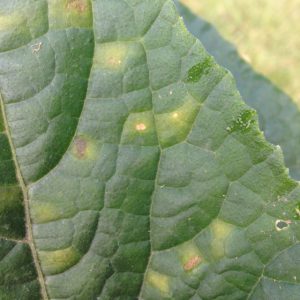 plot (see previous posts for explanation of these plots) at the Snyder Research and Extension Farm in Hunterdon County showed that the cucumber variety ‘Straight 8’ is now infected. This variety is used because it has no resistance to any race of CDM. No other cucurbit crops in the plot were infected. The sentinel plots at Snyder Farm and RAREC are just two of a network of sentinel plots in the eastern half of North America that will contribute information to the CDM forecast (http://cdm.ipmpipe.org/). These plots are scouted weekly for the presence of CDM. If found, the disease is reported to NC State Univ., the organization managing the forecast. Affected crops are also identified. The purpose of this is to provide early warning to growers of these crops so that they may react proactively to the disease, and treat the appropriate crops. A this time, it is important for all cucurbit growers to check the above website at least weekly for updates on the movements of CDM in the eastern U.S. While the imminent threat appears to be confined to cucumber, infections on other crops such as musk melon and butternut squash have been reported in western PA. As of 7/17/17, the CDM forecast issued by NC State had NJ at moderate-to-high risk to develop infections from regional sources, and new
plot (see previous posts for explanation of these plots) at the Snyder Research and Extension Farm in Hunterdon County showed that the cucumber variety ‘Straight 8’ is now infected. This variety is used because it has no resistance to any race of CDM. No other cucurbit crops in the plot were infected. The sentinel plots at Snyder Farm and RAREC are just two of a network of sentinel plots in the eastern half of North America that will contribute information to the CDM forecast (http://cdm.ipmpipe.org/). These plots are scouted weekly for the presence of CDM. If found, the disease is reported to NC State Univ., the organization managing the forecast. Affected crops are also identified. The purpose of this is to provide early warning to growers of these crops so that they may react proactively to the disease, and treat the appropriate crops. A this time, it is important for all cucurbit growers to check the above website at least weekly for updates on the movements of CDM in the eastern U.S. While the imminent threat appears to be confined to cucumber, infections on other crops such as musk melon and butternut squash have been reported in western PA. As of 7/17/17, the CDM forecast issued by NC State had NJ at moderate-to-high risk to develop infections from regional sources, and new 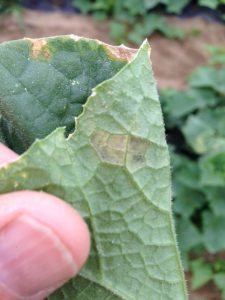 infections may have resulted from rains that evening. Since then, the threat of new infections has subsided, but ALL cucurbit crops should be scouted for the presence of CDM, and all cucumber plantings should be treated preventively. CDM causes yellow lesions to develop on the upper leaf surface (see photo above at right). Lesions are confined within veins initially, but coalesce quickly to kill the entire leaf when moist conditions prevail. Beneath these lesions (lower leaf surface), dark gray spores will be produced (see lower photo at right). If discovered, please report any incidence of CDM to your county agent as soon as possible.
infections may have resulted from rains that evening. Since then, the threat of new infections has subsided, but ALL cucurbit crops should be scouted for the presence of CDM, and all cucumber plantings should be treated preventively. CDM causes yellow lesions to develop on the upper leaf surface (see photo above at right). Lesions are confined within veins initially, but coalesce quickly to kill the entire leaf when moist conditions prevail. Beneath these lesions (lower leaf surface), dark gray spores will be produced (see lower photo at right). If discovered, please report any incidence of CDM to your county agent as soon as possible.
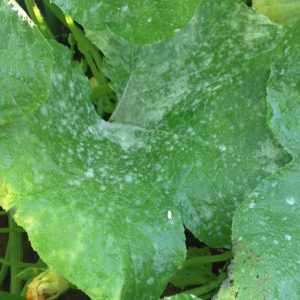 This week, the earliest plantings have begun to develop signs of powdery mildew (PM) infections. This disease is not nearly as destructive as DM, but must be managed sufficiently to permit continued vine health. PM lesions first appear as circular clusters of conidia (spores) on the upper or lower surface of older leaves (see photo at left). PM typically appears as the earliest fruit are developing. The threshold for beginning the PM protectant fungicide program is the appearance of 2 leaves with lesions out of a sample of 100 older leaves. For a comprehensive list of useful fungicides and their use in rotation, see the Pumpkin and Winter Squash section of the 2016-17 Commercial Vegetable Recommendations Guide.
This week, the earliest plantings have begun to develop signs of powdery mildew (PM) infections. This disease is not nearly as destructive as DM, but must be managed sufficiently to permit continued vine health. PM lesions first appear as circular clusters of conidia (spores) on the upper or lower surface of older leaves (see photo at left). PM typically appears as the earliest fruit are developing. The threshold for beginning the PM protectant fungicide program is the appearance of 2 leaves with lesions out of a sample of 100 older leaves. For a comprehensive list of useful fungicides and their use in rotation, see the Pumpkin and Winter Squash section of the 2016-17 Commercial Vegetable Recommendations Guide.
Tomatoes
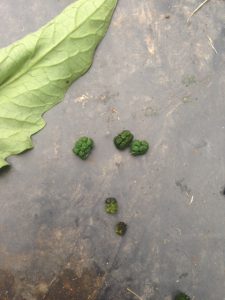 Recently, tomato plantings both in high tunnels and in the field, have developed infestations of tomato hornworm (THW). This caterpillar is often first detected by droppings (see photo at left) or the damage it causes to foliage, where it tends to strip branches of their leaflets, leaving bare stems. THW will also feed on green fruit as the caterpillars grow large enough to
Recently, tomato plantings both in high tunnels and in the field, have developed infestations of tomato hornworm (THW). This caterpillar is often first detected by droppings (see photo at left) or the damage it causes to foliage, where it tends to strip branches of their leaflets, leaving bare stems. THW will also feed on green fruit as the caterpillars grow large enough to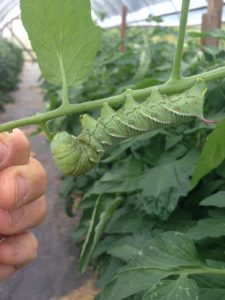 take large scoops of tissue out of the fruit. Some recently detected larvae have been quite large(see photo at right), and can cause significant injury to individual plants. While this damage is frequently more a nuisance than an economic threat in the field, their population can become high enough to warrant treatment in the high tunnels. If characteristic feeding is appearing in multiple sites within tunnels, or under rare circumstances in the field, consider treating for THW. Spot treatments may be effective in high tunnels. There are a number of useful materials, including those in IRAC group 28 (Coragen) and IRAC group 5 (Radiant, Entrust – OMRI listed). A complete list may be found in the 2016-17 Commercial Vegetable Production Recommendations.
take large scoops of tissue out of the fruit. Some recently detected larvae have been quite large(see photo at right), and can cause significant injury to individual plants. While this damage is frequently more a nuisance than an economic threat in the field, their population can become high enough to warrant treatment in the high tunnels. If characteristic feeding is appearing in multiple sites within tunnels, or under rare circumstances in the field, consider treating for THW. Spot treatments may be effective in high tunnels. There are a number of useful materials, including those in IRAC group 28 (Coragen) and IRAC group 5 (Radiant, Entrust – OMRI listed). A complete list may be found in the 2016-17 Commercial Vegetable Production Recommendations.
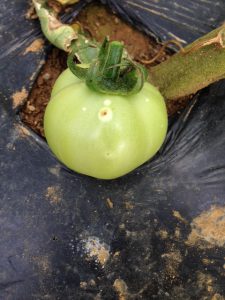 Frequent, heavy rains in parts of the state have caused latent bacterial canker infections to
Frequent, heavy rains in parts of the state have caused latent bacterial canker infections to 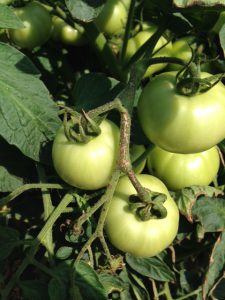 become more serious. This disease causes foliar and fruit injury. Although foliar lesions can at times be mistaken for early blight, the fruit (photo at left) and stem lesions (photos at right) are characteristic. Lesions on stems and petioles are dry and light in color, while the fruit lesion (called bird’s eye spot) is a blister with a whitish halo.
become more serious. This disease causes foliar and fruit injury. Although foliar lesions can at times be mistaken for early blight, the fruit (photo at left) and stem lesions (photos at right) are characteristic. Lesions on stems and petioles are dry and light in color, while the fruit lesion (called bird’s eye spot) is a blister with a whitish halo.
